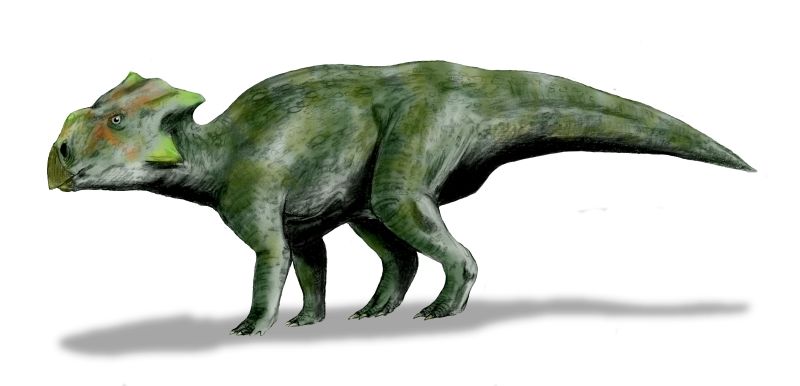- Bagaceratops
Taxobox|
name = "Bagaceratops"
fossil_range =Late Cretaceous
regnum =Animal ia
phylum = Chordata
classis =Sauropsid a
superordo =Dinosaur ia
ordo =Ornithischia
subordo =Cerapoda
infraordo =Ceratopsia
familia =Protoceratopsidae
subfamilia =

genus = "Bagaceratops"
genus_authority = Maryanska & Osmolska (1975)
subdivision_ranks =Species
subdivision = "B. rozhdestvenskyi""Bagaceratops", meaning "small-horned face" (
Mongolian "Baga" = "small"; Greek "ceratops" = "horn face"), is agenus ofceratopsian dinosaur that lived in what is nowMongolia around 80 million years ago, during the LateCretaceous . Although emerging late in the reign of the dinosaurs, "Bagaceratops" had a fairly primitive anatomy and kept the small body size that characterized early ceratopsians.Description
"Bagaceratops" grew to an adult size of about 1 m (3 ft) long, 0.5 m (1.5 ft) high, and weighed around 22 kg (50 lb). It had a smaller frill (which lacked fenestrae), and only ten grinding teeth per jaw, and more triangular skull than its close relative, "
Protoceratops "."Bagaceratops" evolved later but retains more primitive characteristics than its earlier relative."Bagaceratops." In: Dodson, Peter & Britt, Brooks & Carpenter, Kenneth & Forster, Catherine A. & Gillette, David D. & Norell, Mark A. & Olshevsky, George & Parrish, J. Michael & Weishampel, David B. "The Age of Dinosaurs". Publications International, LTD. p. 132. ISBN 0-7853-0443-6.] Otherwise the two dinosaurs were very similar, each had a beak but no brow horns, and a small horn-like prominence on the snout.
Discovery and Species
The first remains of "Bagaceratops" were discovered in the Gobi Desert during the 1970s by a joint expedition composed of Mongolian and Polish scientists. Several of these "Bagaceratops" specimens are currently housed in
Warsaw ,Poland 'sPaleobiological Institute ."Bagaceratops" is currently known from five complete and twenty partial crania, the longest of which is 17 cm long. The skulls are spread throughout the life cycle of the animal, with the smallest being only 4.7 cm long, so the growth cycle is relatively well understood. The smaller juvenile skulls were about the same size as a golf ball. Sadly, only fragmentary remains of "Bagaceratops" post-cranial anatomy have been found. Juvenile remains, initially tentatively named "Protoceratops kozlowskii", and then renamed "
Breviceratops kozlowskii" by Kurzanov in 1990 are now felt to be juvenile "Bagaceratops". Sereno (2000) explained this by extrapolating that the juvenile "Breviceratops " would grow into a mature "Bagaceratops"."Bagaceratops" Species
The type species, "B. rozhdestvenskyi", was named in honor of the Russian
paleontologist A. K. Rozhdestvensky .* "B. rozhdestvenskyi"
Classification
"Bagaceratops" belonged to the Ceratopsia, a group of herbivorous dinosaurs with
parrot -like beaks which thrived inNorth America andAsia during the Cretaceous Period, which ended roughly 65 million years ago. Within this, it has been alternately placed in theProtoceratopsidae or its own new family, theBagaceratopsidae .Fact|date=July 2008Diet
"Bagaceratops", like all ceratopsians, was a
herbivore . During the Cretaceous, flowering plants were "geographically limited on the landscape", and so it is likely that this dinosaur fed on the predominant plants of the era: ferns, cycads and conifers. It would have used its sharp ceratopsian beak to bite off the leaves or needles.ee also
Related animals
* "Protoceratops " Contemporaries
*Ankylosaurs
*Lizard s
*"Oviraptor "
* Smallmammals
*"Velociraptor "References
External links
* [http://hoopermuseum.earthsci.carleton.ca/ceratopsid/bagaceratops.html HVNHM on "Bagaceratops"]
* [http://www.gondwanastudios.com/info/baga.htm Bagaceratops, Gondwana Studios]
Wikimedia Foundation. 2010.
